Go to Central Peru bird tour page | Peru bird tours | Neotropical trip reports | All our birding tours
DOWNLOAD TRIP REPORT
14-28 September 2019
By Eduardo Ormaeche
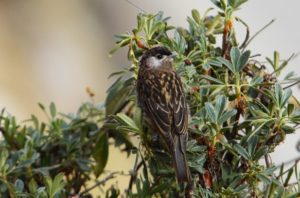
Overview
Our group for this tour had done a Comprehensive Northern Peru tour with us some years ago, which included the beautiful Cordillera Blanca and the Polylepis forest at the base of the Huascarán mountain, so they asked us to do a shorter version of our 21-day trip, deleting the third week.
Nevertheless our Central Peru tour 2019 was one of the most enjoyable trips I have ever led along this great birding route. Perhaps this would not be the ideal destination for the less adventurous birder, as the trip is a fabulous, long drive across four Peruvian states, providing the opportunity to explore the most mega-diverse habitats in the country, such as the Pacific shores along the coast of Lima, the dry inter-Andean valleys, the high Andes with their respective ecosystems including bog cushion habitats at the base of the snow-capped mountains, Polylepis forest, high plateaus covered by tussocks like the Junín Altiplano, elfin Andean forest, cloudforest mountains, and upper-tropical mountains where the Andes meet the Amazon. We can translate this description of habitats into a great set of endemics and range-restricted species.
On this trip we saw some classic South American and most-wanted species such as Torrent Duck, Andean Condor, Andean Cock-of-the rock, Hoatzin, Giant Hummingbird, Sword-billed Hummingbird, Sunbittern, and Golden-headed Quetzal as well as a large number of exquisite endemic and range-restricted species such as Great Inca Finch, Rufous-breasted Warbling Finch, White-bellied Cinclodes, Diademed Sandpiper-Plover, Junin Grebe, White-cheeked Cotinga, Chestnut-crested Cotinga, Bay-vented Cotinga, Black-spectacled Brushfinch, White-eared Solitaire, Fiery-throated and Black Metaltails, Eye-ringed Thistletail, Rufous-bellied Seedsnipe, Raimondi Yellow Finch, Slender-billed Finch, and Cloudforest Screech Owl. We also managed to see a species described just six years ago, the Junin Tapaculo, and some yet undescribed taxa like the Mantaro Valley specialists.
Central Peru used to be one of the most popular birding destinations in Peru back in the 1970s, when several species were described to science for the first time. But those days seems to be out of fashion, perhaps because the northern Peru route has become more accessible to travelers during the last years. But central Peru still not only offers a great introduction to the tropics but also is obligatory for world listers due to its large range of endemic birds. However, the inconvenience of the horrid traffic along the first 100 kilometers (62 miles) of the Central Highway, the fact that the trip takes you to high elevations in the Andes close to 4800 meters (15748 feet) above sea level, and the lack of top birding resorts and lodges might discourage some birders, but on the other hand there are fewer crowds on this tour and it is less busy at the birding hot spots. To me it is a great pleasure to lead this tour. Without many birding facilities such as hummingbird feeders and antpitta stations it is an enjoyable old-school birding tour and very much an overland vehicle trip over the Andes.
We encourage you to take this trip for a great experience in the Andes of South America. We managed to record 344 species, including, 34 Peruvian endemics, 17 near-endemics found in Peru and in one adjacent country only, three undescribed taxa, and 30 species of hummingbirds despite the absence of hummingbird feeders.
Detailed Report
Day 1, September 14th 2019. Lomas de Asia, Cañete River, and transfer to Santa Eulalia
We had an early start, meeting in our nice hotel in Miraflores and then heading south of Lima to the Lomas de Asia reserve. During the last few years this reserve provided excellent opportunities for some of the harder species in the classic Lomas de Lachay reserve north of Lima. Therefore this time we tried for two endemic species that were missing on our list of endemics species of the state of Lima and which we had missed in our Lomas de Lachay visit in 2012. During the drive south of Lima we passed the shores of the Pacific Ocean (Costa Verde), getting glimpses of Kelp and Belcher’s Gulls, Neotropic Cormorant, Inca Tern, and West Peruvian Dove. We arrived at Lomas de Asia and immediately, as soon as we got out of the vehicle, we saw our first Oasis Hummingbird male together with some nice Amazilia Hummingbirds feeding in the flowers not far from the entrance. Other birds included Collared Warbling Finch, Cinereous Conebill, Band-tailed Sierra Finch, Peruvian Meadowlark, Blue-black Grassquit and Short-tailed Field Tyrant. We did not have to wait too long until we saw our first target of the day, Raimondi Yellow Finch; we had nice views of two pairs along the main trail. We arrived at the benches area, when suddenly we saw our second target, the endemic Thick-billed Miner. We had superb, close-up views of two birds two meters from us. Amazing! The weather was perfect, and we found our birds so quickly that we decided to add to our itinerary an unexpected visit to the Cañete River to look for the most-wanted Slender-billed Finch. Even though this would include a long drive and getting to our hotel at dusk it was a good try after that first shock of good luck. I am glad that we made that decision, because as soon as we arrived at the Cañete River we found an unexpected lifer, Black-lored Yellowthroat, and had great views of Bran-colored Flycatcher, which is a potential split, “Rufescens Flycatcher”, another potential lifer for the group. It took us a while, but we managed to have good but quick views of Slender-billed Finch. We had a nice lunch served by Julio, our driver and master chef. Continuing birding, we added American Kestrel, Scrub Blackbird, Long-tailed Mockingbird, and Chestnut-throated Seedeater and heard Plumbeous Rail and Black-necked Woodpecker, but we did not pursue them as we had seen both previously during our Northern Peru tour in 2012. We started the long drive on the connection of southern Lima with the eastern part of Lima, the Central Highway. Driving directly to Santa Eulalia we had to deal with the Central “Nightmare” Highway, as it was at the peak of rush hour. After some road complications we managed to arrive at our lodge and enjoyed a tasty dinner with a cold beer. A good start!
Day 2, September 15th 2019. Santa Eulalia road
We left our lodge at predawn, started to drive the entire Santa Eulalia road above the Santa Eulalia Valley, from 1000-3500 meters (3280-11482 feet) above sea level along one of the roads with the most dramatic views in Peru, and spent the morning targeting Peruvian endemics and west-slope specialists. Our first stop produced good views of Oasis Hummingbird, Andean Swift, American Kestrel, the endemic Great Inca Finch, White-browed Chat-Tyrant, and Yellow-billed Tit-Tyrant. Unfortunately the Streaked Tit-Spinetail did not want to play at all. We climbed higher along the road and went directly to the village of Huachupampa, and not far from the entrance we had tremendous views of the endemic and elusive Rufous-breasted Warbling Finch. This having been the big target of the day we now could rest more easily. The sky was open and bright, perfect conditions for Andean Condor, but we did not find it. However, Black-chested Buzzard-Eagle and Variable Hawks were seen on more than one occasion. We also enjoyed the impressive Giant Hummingbird, several male Peruvian Sheartails, Sparkling Violetear, Blue-and-yellow Tanager, Mourning Sierra Finch, Band-tailed Seedeater, the endemic Black-necked Woodpecker, Pied-crested Tit-Tyrant, Greenish Yellow Finch, Pacific Pygmy Owl, Ash-breasted Sierra Finch, Canyon Canastero, Hooded Siskin, Cinereous Conebill, Bare-faced and Black-winged Ground Doves, Spot-winged Pigeon, Andean Tinamou, Rusty-crowned Tit-Spinetail, and remarkable views of the endemic Bronze-tailed Comet. By lunchtime the activity had slowed down; however, we still found the endemic Rusty-bellied Brush Finch, Golden Grosbeak, Chiguanco Thrush, Rufous-collared Sparrow, Purple-collared Woodstar, and House Wren while enjoying some snacks made by our master chef. We drove back to the Puente Autisha area, making several stops to look for Streaked Tit-Spinetail, but unfortunately to no avail.
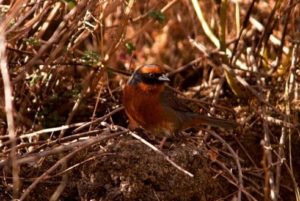
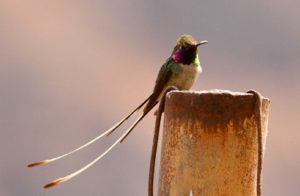
We drove back to our lodge after spending some time birding at lower elevations in the Santa Eulalia Valley. It was a great day indeed, even though the Streaked Tit-Spinetail managed to elude us. A good dinner was followed by an early bedtime to rest and get ready for the next day.
Day 3, September 16th 2019. Marcapomacocha and transfer to Concepción
Marcapomacocha and the road to Milloc area, at 4700 meters (15419 feet) above sea level between the borders of the states of Lima and Junín at the base of snow-capped mountains, is a habitat of a great set of high-elevation birds that have made the name Marcapomacocha almost legendary among birders. We had a whole morning to look for several targets, and we knew that we had to take it easy because of the high elevation. Fortunately we had good weather on our side, and the birds were very active. We started the day with views of Creamy-winged Cinclodes as well as of several Bright-rumped Yellow Finches, Black Siskin, White-winged Diuca Finch, and Plumbeous Sierra Finch.
We passed the mining sector and went directly to the habitat of one of the most-wanted species in the world, Diademed Sandpiper-Plover. We explored the bog cushions of Marcapomacocha, and there it was, our Diademed Sandpiper-Plover in the scope! We also had excellent views of Olivaceous Thornbill, Ochre-naped, Cinereous, and Taczanowski’s Ground Tyrants, and a magnificent Andean Condor with two Mountain Caracaras soaring above us.
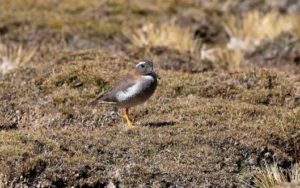
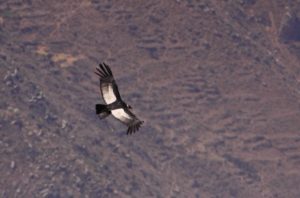
We left Marcapomacocha toward the Ticlio Pass, the highest mountain pass in the Peruvian Andes 4818 meters (15807 feet) above sea level. Before the pass we had scope views of Giant Coot and the endemic and Critically Endangered (IUCN) White-bellied Cinclodes, which performed amazingly for us. We also had a nice view of Culpeo (Andean Fox), which is the second-largest canid in South America. Birding the high pass proper we saw the endemic Dark-winged Miner, Slender-billed Miner, Buff-breasted Earthcreeper, Mountain Caracara, Andean Flicker, Andean Goose, Andean Gull, Streak-backed Canastero, and the most-wanted Rufous-bellied Seedsnipe. Then we headed toward Concepción in Junín state for an overnight.
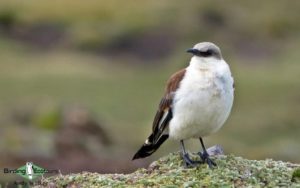
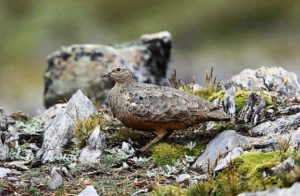
Day 4, September 18th 2019. Satipo Road (upper parts)
On this, perhaps one of the longest days of the trip, we left Concepción to bird the upper parts of the famous Satipo Road. Due to the lack of accommodation and facilities we strategically focus on the high and mid elevations of the Satipo Road on our first day here, drive all the way down to Satipo, and later focus only on the mid to low elevations of this so productive road. The upper parts of the road did not add any new species as we climbed high to 4000 meters (13123 feet) near Lake Pomacochas. We did see Andean Goose and Andean Gull, but the best was a pair of Aplomado Falcons on a rock near the road. We drove directly to Puente Carrizales, but not before we had great views of the still-undescribed “Millpo Tapaculo”. This part of the Mantaro Valley still holding at least three different taxa that still wait for scientific description, and a new species of Scytalopus, Junin Tapaculo, has been described to science recently. It took a time, but we finally found our first target, the endemic Fiery-throated Metaltail, and minutes later we had super views of the range-restricted and endemic Eye-ringed Thistletail.
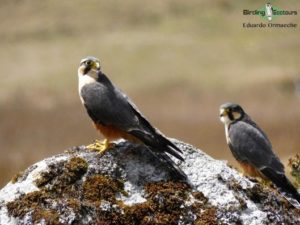
We arrived in the cloudforest and managed to find Crimson-mantled Woodpecker, Smoke-colored Pewee, Scarlet-bellied Mountain Tanager, Slaty Brushfinch, Barred Fruiteater, and the endemic Peruvian Wren. Then we started the long drive to Satipo, knowing that we would return for more
Day 5, September 19th 2019. Apalla-Andamarca Road
Again we had a predawn start to get back to the road. Today we planned to explore the Apalla-Andamarca Road on the Mantaro Valley slope and focus on a handful of endemics and undescribed species in this remote area of Peru. We had an excellent start with birds such as the endemic Creamy-crested Spinetail, Citrine Warbler, White-winged Black Tyrant, Golden-billed Saltator, and in the same area “Mantaro Wren” and the endemic Black-spectacled Brushfinch. What a start! We continued birding the drier parts of the road until we arrived in the habitat of “Mantaro Thornbird”, which did not prove too difficult for us.
With the three top birds for this section of the valley in the bag we went back to the humid cloudforest area to add three more endemics, namely Tschudi’s Tapaculo, Junin Tapaculo, and Marcapata Spinetail. Sadly Chestnut Antpitta did not play for us. However, we found other excellent birds such as Grey-breasted Mountain Toucan, Northern Mountain Cacique, Hooded Mountain Tanager, White-banded Tyrannulet, White-throated Tyrannulet, Pearled Treerunner, Barred Fruiteater, Streaked Tuftedcheek, Mountain Wren, and Inca Jay.
Then we birded the Satipo Road again on the way back to Satipo, and we enjoyed the hoped-for Andean Cock-of-the-rock. We could have found more birds, but we had to cover some distance before getting back to Satipo. We left in good time and descended to the tropical weather of Satipo and back to our favorite restaurant, La Vaquita Loca, for a great dinner, a cold beer, and a toast to another long, great day.
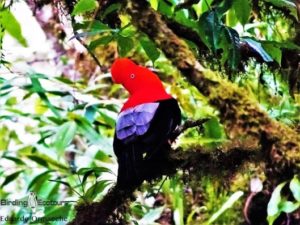
Day 6, September 20th 2019. Satipo Road (lower parts) and transfer to Oxapampa
We had another predawn start to explore the lower parts of the Satipo Road. We had a tasty breakfast made by our master chef and were ready at dawn for the birds. On the way we flushed a Pauraque off the road and then had nice views of Andean Motmot, Bluish-fronted Jacamar, Dusky-green Oropendola, a pair of Rufous-capped Nunlets, Long-tailed Tyrant, Great Kiskadee, Social Flycatcher, White-browed Antbird, Blackish Antbird (heard only), and Bay-headed, Spotted, Paradise, and Magpie Tanagers. We were searching for Amazonian Umbrellabird, but without success. Then we saw Fasciated Tiger Heron along the river. Farther up we found Blue-banded Toucanet and Versicolored Barbet, and as the morning ended we continued our journey toward Ulcumano Lodge in Oxapampa in the Pasco state.
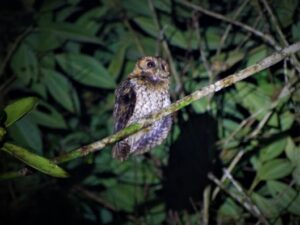
We were welcomed by our host, who after checking us into our rooms and providing us with a great dinner took us to a new site for the most-wanted species on his property, the little-known Cloud-forest Screech Owl. We scored with this owl on our first night at Ulcumano Lodge, and the next day was full of promises.
Day 7, September 21st 2019. Ulcumano Lodge
We spent the whole morning birding the lodge surroundings after enjoying an amazing breakfast. We found Tricolored Brushfinch, Striped Treehunter, Buff-browed Foliage-gleaner (heard only), and the striking White-eared Solitaire. In addition Flavescent Flycatcher, Yellow-throated Tanager were found, and our main targets were about to come. First we had great views of the endemic Rufous-vented Tapaculo followed by good views of the endemic Masked Fruiteater, Andean Motmot, Rufous-booted Racket-tail, Long-tailed Sylph, Bronzy Inca, and Chestnut-breasted Coronet. We tried hard for the endemic Bay Antpitta but had no success in the morning, as the bird was quiet. Then we had the first rain on the trip and went back to the lodge, but not before watching the splendid Chestnut-crested Cotinga in the scope. The afternoon was quiet, and we decided to give Bay Antpitta another try, but it seemed that the bird was not vocal at this time of the year around Ulcumano Lodge. We saw Red-throated Caracara, unusual at the lodge’s elevation, and then hit a flock with species such as Beryl-spangled Tanager, Yellow-throated Tanager, Mottle-cheeked Tyrannulet, Streaked Xenops, Variable Antshrike, Common Bush Tanager, and Sickle-winged Guan.
Day 8, September 22nd 2019. Bosque Fundo Armorique
We left Ulcumano and drove towards La Merced where we met our local contact who took us to the recently opened Fundo Armorique, a local coffee plantation with a huge undisturbed forest (Bosque Fundo Armorique) above on the mountains. The drive from the main road to the forest can be tricky and is possible impassable without a 4×4 during the rainy season, when it can get very muddy. Fortunately we did not have that problem and arrived rather quickly at the plantation. Our first bird was Round-tailed Manakin; we had good views of at least three males at the lek. Then we returned to the vehicle and drove near the top of the forest on the mountain. The birding was outstanding. not only did we find our main target, the endemic Creamy-bellied Antwren, which proved a bit tricky this time, but also saw unexpected species like the endemic Cerulean-capped Manakin, Rufous-breasted Wood Quail, Ocellated Piculet, Chestnut-backed Antshrike, Blue-headed Parrot, White-backed Fire-eye, Plain-winged Antshrike, Stripe-chested Antwren, White-crowned Manakin, Scale-crested Pygmy Tyrant, Streaked Xenops, and Montane Foliage-gleaner. We heard Northern White-crowned Tapaculo but did not try for it, as we were trying to catch a bigger fish, Brown Tinamou, which came closer but not close enough.
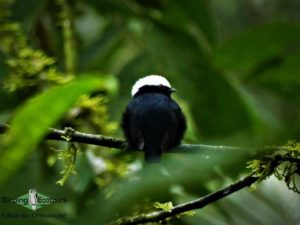
After a great session in the morning we drove back to the plantation, where there was open country and we saw common species such as Common Tody-Flycatcher, Swallow Tanager, Speckled Chachalaca, Blue-grey Tanager, Palm Tanager, White-necked Jacobin, and Black-breasted Mango.
We then left the Chanchamayo Valley and drove to Tarma, where we found ourselves trapped in a local parade with hundreds of people and a nightmare traffic jam – the worst thing you can expect after a long birding day. The noise took some time to vanish, but fortunately a nice beer helped us to get some deserved rest at the end of the day.
Day 9, September 23rd 2019. Lake Junín and drive to Huánuco
We left Tarma and drove to the shores of Lake Junín. This largest lake entirely within Peruvian territory is part of the Junín National Reserve, which is of great natural, environmental, and historical importance. To see the flightless, Critically endangered (IUCN), and endemic Junin Grebe we had to drive to Ondores and from there take a small boat across the lake to the Cazapatos sector, where a big population of the grebe still occurs. We arrived at Ondores in time to have breakfast and look for our first target, the local subspecies of Black Rail, which is considered by some authorities to be as a different species, Junin Rail. With the help of Cesar, the local boatman and bird guide in the Junín Lake area, we managed to track down this once mythical and almost impossible-to-see species. We had great looks of one individual on the tall grass at the lake edge. Another outstanding bird was a male Black-breasted Hillstar perched on a huge bolder, giving us great views. The lake was full of the classic Andean waterfowl, with species including Cinnamon Teal, Puna Teal, Yellow-billed Teal, Yellow-billed Pintail, Crested Duck, and Andean Duck. Several Andean Coots, Wilson’s Phalarope, Baird’s Sandpiper, Greater Yellowlegs, and hundreds of Chilean Flamingos provided a beautiful natural backdrop. We also managed to find a fabulous couple of Junin Grebes. Perfect! Other birds on the lake included Silvery Grebe, Andean Negrito, Andean Goose, Puna Ibis, Andean Lapwing, Andean Flicker, Black-billed Shrike-Tyrant, and Cinereous Harrier. Later we drove along the Ondores road and found at least three Puna Snipes and a Lesser Horned Owl roosting at daytime.
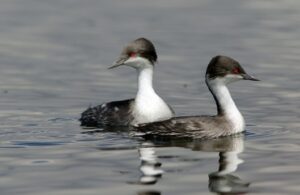
We continued our drive across the Andes until we arrived in Huánuco, the capital city of the Huánuco state, for a three-night stay. We checked into our comfortable hotel, ready for dinner and a cold beer.
Day 10, September 24th 2019. Bosque Unchog
So far, after 10 days of fun and adventure, we could boast not only about the success with our targets but also about the great weather we had during the tour. Sadly today was an exception. We left Huánuco before dawn in order to be on time at the famous Bosque Unchog elfin forest. After a couple of hours we arrived on time at Bosque Unchog for breakfast, and as soon as we had finished and were ready for our birding hike the clouds covered the sky and it really looked like rain. We had to play it by instinct and continued walking, as the rain might take some time to fall. We soon found the endemic Coppery Metaltail, Line-fronted Canastero, Red-crested Cotinga, and Moustached Flowerpiercer. Later we saw White-chinned Thistletail, and right there the rain came and did not stop except for a few minutes during the entire morning. It spoiled the birding day and the chances to score our targets. But despite the fact that we had to be careful while walking down a narrow, steep trail we did well and managed to get to our usual site for the endemic Golden-backed Mountain Tanager, which, however, couldn’t be found. We waited for a while until the rain stopped for a few minutes, which gave us some bird activity. We found a flock with White-banded Tyrannulet, White-throated Tyrannulet, Pearled Treerunner, Hooded Mountain Tanager, Chestnut-bellied Mountain Tanager, Yellow-scarfed Tanager, and Golden-collared Tanager. All these birds passed very fast, and it was difficult to follow them through the low canopy of the elfin forest. After some minutes, though, we had great views of the endemic Bay-vented Cotinga perched in front of us. Then another good species showed up nicely, Pardusco. We waited for a few hours, but there was no sign for the weather to get better; in fact it got worse, so we decided to start the hike back to the car. Before we left the site we had splendid views of the endemic Neblina Tapaculo.
Before we arrived at the little community of Cochabamba located below Bosque Unchog we found another endemic, the range-restricted Brown-flanked Tanager. On the way to the main road we crossed the dry section of the valley, a suitable habitat for the endemic Spot-throated Hummingbird, which we saw right away. Other birds included Pacific Pygmy Owl, Fasciated Wren, and White-bellied Hummingbird.
Another day had passed, and we were ready for another delicious dinner and a good checklist session. Over dinner we decided to skip our extra day at Bosque Unchog and switch it to another locality. It was a hard decision for everybody, but it would have been difficult to repeat the hike on another rainy day, and the forecast was showing rain for the Huánuco area again. So we decided to do the best for the group’s safety and enjoyment, and I came with a good option for the next day, namely a morning in the tropical lowlands of Tingo Maria to look for Blue-headed Macaw, which was on the wish list of the participants but had not been expected to be found on the tour.
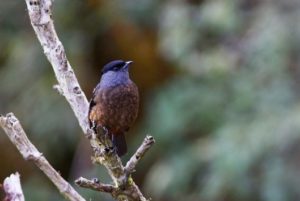
Day 11, September 25th 2019. Tingo Maria and Villa Jennifer Lodge
We had another predawn start, drove to Tingo Maria, and arrived at the entrance of the Tingo Maria National Park, where we stopped and started to scan the forest clearing, canopy, and river looking for the macaw. We saw flocks of White-eyed Parakeets, White-winged Swallow, White-banded Swallow, Southern Rough-winged Swallow, and Blue-grey Tanager and a glimpse of Blue-headed Macaw silhouetted in the sky. Well, not good enough! We explored some areas away from the main road, following the Monzón and Huallaga Rivers. We found Swallow-winged Puffbird, Black-capped Donacobius, and Hoatzin, but no trace of the macaw. So we decided to return to the entrance of Tingo Maria National Park, where we finally found a couple of Blue-headed Macaws perched in a tree and giving exquisite scope views.
Then we went to bird the Villa Jennifer Lodge, where we were able to add more species to our day list, including Bluish-fronted Jacamar, the endemic Huallaga Tanager, Ringed Kingfisher, Amazon Kingfisher, Bat Falcon, Orange-backed Troupial, Golden-tailed Sapphire, Chestnut-eared Aracari, Grey-capped Flycatcher, and the silhouettes of Military Macaws.
After lunch in the lodge we drove back to Huánuco with a stop at the Carpish Tunnel. Once one of our favorite birding spots, the habitat now is dramatically disappearing due to large-scale deforestation and the introduction of Hortensia (Hydrangea macrophylla) for commercial purposes. We made a brief stop at the tunnel to add Violet-throated Starfrontlet and Amethyst-throated Sunangel, and back at our hotel in Huánuco we celebrated another good birding day.
Day 12, September 26th 2019. Kotosh and drive to La Oroya
The original plan for today had been a day of travel between Huánuco and La Oroya with some birding along the way. But was there was nothing new left for the group to see, except one country endemic, Junin Canastero, so we decided to have a late start, to enjoy the hotel breakfast, and before hitting the road to make a short visit to the pre-Hispanic site of Kotosh, five kilometers from the city of Huánuco. The Temple of the Crossed Hands is one of the oldest ancient religious archaeological sites in the Americas, around 4,000 years old. The visit was an interesting and educational experience. There were not many birds at the site except for a few Fasciated Wrens and Blue-and-white Swallows.
After a short visit we found ourselves getting out of bustling Huánuco and hitting the road again. We made a stop outside Huánuco, and, although it took a while, we found Rufous-backed Inca Finch. Then we drove along the Polylepis forest of La Quinua but we did not stop, as we had birded the Huascarán National Park in 2012, finding all the Polylepis specialists except one, which was left for the very last day of this tour. We started climbing, and a couple of hours later we were back at 4000 meters (13123 feet) in the Junín plains. It was nice to see troops of wild Vicuñas; this amazing animal is recovering from its once very endangered existence. We looked for a good spot that would allow our driver and master chef to prepare some tasty soup while we were determined to find our target. And after a few minutes there it was, the endemic Junin Canastero. With the canastero in the bag we made our way back to La Oroya. Sleeping at 3800 meters (12467 feet) is not an easy task, but the new hotel in town is so comfortable that we had a good night’s sleep to get ready for our last birding day in the Central Andes.

Day 13, September 27th 2019. Polylepis Forest and transfer back to Lima
We had another early start to leave La Oroya on the route to Marcapomacocha, then to the detour to Milloc, and then we connected with the Santa Eulalia road once more. In the upper parts of the Santa Eulalia Valley at 3700 meters (12139 feet) there is a patch of Polylepis forest called Japaní. This has been a reliable site for the endemic and most-wanted White-cheeked Cotinga for some years, and we were determined to get it after having missed it in 2012. We arrived at the site before 8 a.m. in time for coffee, set up the scope, and started to look for our target. By the road we found the endemic Rusty-crowned Tit-Spinetail, Mourning Sierra Finch, Peruvian Sierra Finch, and Rufous-collared Sparrow. We also had superb views of the endemic Black Metaltail, D’Orbigny’s Chat-Tyrant, and finally of our target, the exquisite White-cheeked Cotinga. Mission accomplished!
We continued driving the Santa Eulalia road and finding old friends like White-capped Dipper, Torrent Duck, and Great Inca Finch. Sadly we could not find Streaked Tit-Spinetail this time, but we had lots to be happy about and continued the drive to the crazy city of Lima. We arrived at our hotel in the afternoon and went immediately to get a light late lunch, which was perfect for us. Then we said our fairwells, carrying wonderful memories and a huge list of Peruvian endemics.
Day 14, September 28th 2019. Transfer to the airport for departure
The group was met by our private shuttle and transferred to the airport.
BIRD LIST (Taxonomy IOC 9.2)
Tinamidae
Brown Tinamou (H) Crypturellus obsoletus Heard above La Merced
Andean Tinamou Nothoprocta pentlandii Seen along the Santa Eulalia road
Cracidae
Speckled Chachalaca Ortalis guttata Seen and heard above La Merced
Andean Guan Penelope montagnii Seen along the Satipo Road
Sickle-winged Guan Chamaepetes goudotii Seen at Ulcumano Lodge near Oxapampa. Here the subspecies rufiventris
Odontophoridae
Rufous-breasted Wood Quail Odontophorus speciosus Great views of two individuals above La Merced. An amazing encounter with this always hard-to-see species. The species is classified as Near-threatened. Here the subspecies speciosus
Anatidae
Torrent Duck Merganetta armata Great views along the mid Satipo Road. One of the classics of the Andes
Andean Goose Chloephaga melanoptera Nice views at high elevation
Yellow-billed Teal Anas flavirostris Seen on Lake Junín. Here the subspecies oxyptera
Puna Teal Spatula puna Seen on Lake Junín
Yellow-billed Pintail Anas georgica Seen on Lake Junín. Here the subspecies spinicauda
Crested Duck Lophonetta specularioides Great views of this attractive duck at Lake Junín. Here the subspecies alticola
Cinnamon Teal Spatula cyanoptera Seen on Lake Junín. Here the subspecies orinoma
Andean Duck Oxyura ferruginea Seen on Lake Junín. Oxyura ferruginea is split from O. jamaicensis (Ridgely & Greenfield 2001; Jaramillo 2003, Dickinson 2003); lumped by some (H&M4, Fjeldsa 1986, SACC, McCracken & Sorenson 2005) based on hybrid populations (andina) in Colombia
Caprimulgidae
Pauraque Nyctidromus albicollis One seen along the road on the lower Satipo Road
Rufous Nightjar Antrostomus rufus One flushed during our morning hike in the forest above La Merced
Apodidae
Chestnut-collared Swift Streptoprocne rutila Seen along the Satipo Road
White-collared Swift Streptoprocne zonaris Massive flocks above the Satipo Road
Andean Swift Aeronautes andecolus Seen along the Santa Eulalia Valley
Neotropical Palm Swift Tachornis squamata Seen at Villa Jennifer Lodge near Tingo Maria
Trochilidae
Sparkling Violetear Colibri coruscans Seen along the Santa Eulalia Valley
Black-throated Mango Anthracothorax nigricollis Good views above La Merced
Fork-tailed Woodnymph Thalurania furcata Good views above La Merced
Golden-tailed Sapphire Chrysuronia oenone Seen at Villa Jennifer Lodge
Spot-throated Hummingbird Leucippus taczanowskii Seen in the drier sections of the Huallaga Valley near Huánuco. A Peruvian endemic
White-bellied Hummingbird Amazilia chionogaster Seen along the drier part of the Huallaga Valley near Huánuco
Amazilia Hummingbird Amazilia amazilia Seen at Lomas de Asia and the lower parts of the Santa Eulalia Valley
Sapphire-spangled Emerald Amazilia lactea Good views at Villa Jennifer Lodge
Speckled Hummingbird Adelomyia melanogenys Seen at Ulcumano Lodge
Chestnut-breasted Coronet Boissonneaua matthewsii Seen at Ulcumano Lodge
Shining Sunbeam Aglaeactis cupripennis Seen at high elevations between Concepción and Comas
Black-breasted Hillstar Oreotrochilus melanogaster Great views in Marcapomacocha and Junín. A Peruvian endemic
Mountain Velvetbreast Lafresnaya lafresnayi Seen well along the Apalla-Andamarca Road
Bronzy Inca Coeligena coeligena Seen at Ulcumano Lodge
Collared Inca Coeligena torquata Seen along the Satipo Road
Violet-throated Starfrontlet Coeligena violifer Good views in the Carpish Tunnel
Sword-billed Hummingbird Ensifera ensifera Good views along the Satipo Road
Giant Hummingbird Patagona gigas Great views in the upper part of the Santa Eulalia road. The largest hummer in the world
Amethyst-throated Sunangel Heliangelus amethysticollis Seen well at the Carpish Tunnel. Here the subspecies decolor
Rufous-booted Racket-tail Ocreatus addae Seen well at Ulcumano Lodge. Rufous-booted Racket-tail O. addae is split from [White-booted] Booted Racket-tail (Schuchman et al. 2016). Tentatively includes annae. Found in Peru and Bolivia
Black-tailed Trainbearer Lesbia victoriae Seen at suitable habitat along the Satipo Road
Bronze-tailed Comet Polyonymus caroli Great views of a glowing male in the upper Santa Eulalia Valley. A Peruvian endemic
Tyrian Metaltail Metallura tyrianthina Seen at a few locations
Fiery-throated Metaltail Metallura eupogon It took us a while, but we had a good view of one individual at the Carrizales bridge. A Peruvian endemic and restricted to a very tiny portion of the central Andes
Coppery Metaltail Metallura theresiae Good views at Bosque Unchog. A Peruvian endemic
Black Metaltail Metallura phoebe Seen at the White-cheeked Cotinga site in the upper parts of the Santa Eulalia Valley. A Peruvian endemic
Olivaceous Thornbill Chalcostigma olivaceum Incredible views of this most-wanted hummer working on the tiny flowers that grow a few inches above the bog cushion grounds in Marcapomacocha. A real survivor. Found in Peru and Bolivia. Here the subspecies pallens
Long-tailed Sylph Aglaiocercus kingii Good views at Ulcumano Lodge
Oasis Hummingbird Rhodopis vesper Great views at Lomas de Asia. Found in Peru and Chile
Peruvian Sheartail Thaumastura cora Good views along the Santa Eulalia road
Purple-collared Woodstar Myrtis fanny Seen at Lomas de Asia and the Santa Eulalia road
Cuculidae
Groove-billed Ani Crotophaga sulcirostris Several seen along the west slope of the Andes
Smooth-billed Ani Crotophaga ani Seen in the lower parts of the Satipo Road and at Tingo Maria
Squirrel Cuckoo Piaya cayana One noticed a Villa Jennifer Lodge near Tingo Maria
Columbidae
Rock Pigeon Columba livia Common
Spot-winged Pigeon Patagioenas maculosa Good views in the upper Santa Eulalia Valley. Here the subspecies albipennis
Band-tailed Pigeon Patagioenas fasciata Seen along the upper part of the Satipo Road
Plumbeous Pigeon Patagioenas plumbea Seen at the lower Satipo Road
Pale-vented Pigeon Patagioenas cayennensis Seen near Tingo Maria
Bare-faced Ground Dove Metriopelia ceciliae Great views along the Santa Eulalia road
Black-winged Ground Dove Metriopelia melanoptera Excellent views along the upper parts of the Santa Eulalia road
Croaking Ground Dove Columbina cruziana Seen in the Santa Eulalia road and at Lomas de Asia
Ruddy Ground Dove Columbina talpacoti Seen in Tingo Maria and in the lower Satipo area
White-throated Quail-Dove Zentrygon frenata Seen along the Satipo Road
White-tipped Dove Leptotila verreauxi Seen along the Satipo Road, in the Santa Eulalia Valley and at Ulcumano Lodge
Eared Dove Zenaida auriculata Common along the coast. Noticed at Lomas de Asia and in the Cañete Valley
West Peruvian Dove Zenaida meloda Seen at Lomas de Asia and in the Cañete Valley
Rallidae
Black Rail Laterallus jamaicensis Amazing sighting of this not long ago impossible-to-see species in the shore reeds of Lake Junín. The isolated subspecies tuerosi at 4,100 meters (13450 feet) above sea level in central Peru is treated by other authorities as a different species, Junin Rail, being endemic to Lake Junín and Peru.
Plumbeous Rail (H) Pardirallus sanguinolentus Heard at the Cañete River, but we had better fish to fry.
Common Gallinule Gallinula galeata Common at Lake Junín
Andean Coot Fulica ardesiaca Common at Lake Junín
Giant Coot Fulica gigantea A couple of sightings around the Ticlio ponds
Podicipedidae
White-tufted Grebe Rollandia rolland Seen on Lake Junín
Silvery Grebe Podiceps occipitalis Seen on Lake Junín
Junin Grebe Podiceps taczanowskii After a long and pleasant boat trip across Lake Junín we managed to get into the area where this species occurs in the lake. We were rewarded with views of at least four different individuals. This species is endemic to Peru and classified as Critically endangered, with a population no bigger than 200-250 species. The bird is named after Lake Junín, the second largest Andean lake in Peru, and the scientific name commemorates the Polish zoologist Władysław Taczanowski, author of Ornithology of Peru (1884–86). Together with the Titicaca Grebe and the extinct Colombian Grebe and Atitlán Grebe it is a flightless grebe.
Phoenicopteridae
Chilean Flamingo Phoenicopterus chilensis Hundreds on Lake Junín. A nice show
Charadriidae
Andean Lapwing Vanellus resplendens Common at high elevations
Diademed Sandpiper-Plover Phegornis mitchellii Amazing sightings of this high-elevation wader in Marcapomacocha. One of the finest birds, without hesitation. Classified as Near-threatened
Thinocoridae
Rufous-bellied Seedsnipe Attagis gayi Great views in Marcapomacocha. Here the subspecies simonsi. The subspecies latreillii of Northern Ecuador is a good contender for a future split.
Grey-breasted Seedsnipe Thinocorus orbignyianus Good views in the Marcapomacocha area. Here the subspecies ingae
Scolopacidae
Baird’s Sandpiper Calidris bairdii Seen at Lake Junín
Wilson’s Phalarope Phalaropus tricolor Seen at Lake Junín
Spotted Sandpiper Actitis macularius A couple of sightings in the lowlands of Tingo Maria
Puna Snipe Gallinago andina Great views in the marshes of Junín. Here the nominate subspecies
Lesser Yellowlegs Tringa flavipes Seen at Lake Junín
Greater Yellowlegs Tringa melanoleuca Seen at Lake Junín
Laridae
Andean Gull Chroicocephalus serranus Common at high elevations
Belcher’s Gull Larus belcheri A couple of sightings along the coast of Lima. Named after Admiral Sir Edward Belcher (1799 –1877), a British naval officer, hydrographer, and explorer. Found in Peru and Chile
Kelp Gull Larus dominicanus A couple of sightings along the coast of Lima
Inca Tern Larosterna inca A few seen while driving along the coast of Lima. Classified as Near-threatened
Large-billed Tern Phaetusa simplex Good views at the lower Huallaga River near Tingo Maria
Eurypygidae
Sunbittern Eurypyga helias One sighting in Tingo Maria
Phalacrocoracidae
Neotropic Cormorant Phalacrocorax brasilianus Seen along the coast of Lima and in the Tingo Maria marshes
Threskiornithidae
Andean Ibis Theristicus branickii Seen near the Ticlio Pass in the high Andes of Lima. Classified as Near-threatened
Green Ibis Mesembrinibis cayennensis One noticed near Tingo Maria
Puna Ibis Plegadis ridgwayi Common at Lake Junín
Ardeidae
Fasciated Tiger Heron Tigrisoma fasciatum One seen along the Satipo River
Black-crowned Night Heron Nycticorax nycticorax Seen at Lake Junín
Striated Heron Butorides striata Seen in the Tingo Maria marshes
Western Cattle Egret Bubulcus ibis Common
Great Egret Ardea alba Seen in the lowlands of Tingo Maria
Little Blue Heron Egretta caerulea Seen along our long drive to Cañete
Snowy Egret Egretta thula Seen in the Cañete Valley and the tropical lowlands
Pelecanidae
Peruvian Pelican Pelecanus thagus Seen along the coast of Lima. Classified as Near-threatened. Found in Peru and Chile
Opisthocomidae
Hoatzin Opisthocomus hoazin A few seen along the Monzón River in the Huallaga Valley
Cathartidae
Black Vulture Coragyps atratus Common
Turkey Vulture Cathartes aura Common
Andean Condor Vultur gryphus Great views of one individual soaring above Marcapomacocha. Classified as Near-threatened. The national bird of Ecuador, Colombia, Bolivia, and Chile
Accipitridae
Swallow-tailed Kite Elanoides forficatus Seen on the way to Tingo Maria
Cinereous Harrier Circus cinereus A single sighting in the Lake Junín area
Plumbeous Kite Ictinia plumbea Seen in the Tingo Maria area
Variable Hawk Geranoaetus polyosoma Good views in the Santa Eulalia and Marcapomacocha areas
Roadside Hawk Rupornis magnirostris Seen in Tingo Maria
Black-chested Buzzard-Eagle Geranoaetus melanoleucus Good views along the Santa Eulalia road
Strigidae
Cloud-forest Screech Owl Megascops marshalli An amazing score with this mega-rarity at Ulcumano Lodge. A true highlight of the trip. A very small range of distribution in Central Peru and an isolated population in Western Bolivia. Further studies need to be done to understand the populations.
Lesser Horned Owl Bubo magellanicus Roosting at daytime in Ondores near Lake Junín. Bubo magellanicus is split from B. virginianus (König et. al.1999, Jaramillo 2003); SACC awaits analysis and proposal
Pacific Pygmy Owl Glaucidium peruanum Seen in the Santa Eulalia Valley
Ferruginous Pygmy Owl (H) Glaucidium brasilianum Heard distantly at Villa Jennifer
Trogonidae
Golden-headed Quetzal (H) Pharomachrus auriceps Heard at Ulcumano Lodge
Alcedinidae
Amazon Kingfisher Chloroceryle amazona Seen along the Huallaga River
Ringed Kingfisher Megaceryle torquata Seen at Villa Jennifer Lodge
Momotidae
Amazonian Motmot Momotus momota Seen at Villa Jennifer Lodge
Andean Motmot Momotus aequatorialis Good views at Ulcumano Lodge
Rufous Motmot Baryphthengus martii Seen along the lower Satipo Road
Galbulidae
Bluish-fronted Jacamar Galbula cyanescens Seen along the lower Satipo Road
Bucconidae
Rufous-capped Nunlet Nonnula ruficapilla Great views of one pair along the lower Satipo Road
Black-fronted Nunbird Monasa nigrifrons Seen in the Tingo Maria lowlands
Swallow-winged Puffbird Chelidoptera tenebrosa Seen in the Tingo Maria lowlands
Capitonidae
Gilded Barbet Capito auratus Seen at Villa Jennifer Lodge
Versicolored Barbet Eubucco versicolor Seen along the mid Satipo Road
Ramphastidae
Chestnut-eared Aracari Pteroglossus castanotis Seen at the lower Satipo Road
Black-throated Toucanet Aulacorhynchus atrogularis Seen at Ulcumano Lodge
Blue-banded Toucanet Aulacorhynchus coeruleicinctis Seen along the mid Satipo Road. Found in Peru and Bolivia
Grey-breasted Mountain Toucan Andigena hypoglauca Seen along Satipo Road. Classified as Near-threatened
Picidae
Ocellated Piculet Picumnus dorbignyanus Seen above La Merced
Yellow-tufted Woodpecker Melanerpes cruentatus Seen in the Tingo Maria lowlands
Crimson-mantled Woodpecker Colaptes rivolii Seen in the cloudforest of the Satipo Road
Andean Flicker Colaptes rupicola Seen at high elevation
Black-necked Woodpecker Colaptes atricollis Seen along the Santa Eulalia Valley. A Peruvian endemic
Crimson-crested Woodpecker Campephilus melanoleucos Seen in the Tingo Maria lowlands
Falconidae
Black Caracara Daptrius ater Seen in the Tingo Maria lowlands
Red-throated Caracara Ibycter americanus Seen at Ulcumano Lodge
Mountain Caracara Phalcoboenus megalopterus Seen at high elevations
Yellow-headed Caracara Milvago chimachima Seen in the Tingo Maria lowlands
Aplomado Falcon Falco femoralis Amazing close0up views of a pair eating its prey after hunting. A super encounter along the Satipo Road
Bat Falcon Falco rufigularis Seen at Villa Jennifer
American Kestrel Falco sparverius Seen along the Santa Eulalia Valley. The most common raptor on the west slope of the Andes
Psittacidae
Mountain Parakeet Psilopsiagon aurifrons Good views along the Santa Eulalia road
Andean Parakeet Bolborhynchus orbygnesius Great views along the Satipo Road
Cobalt-winged Parakeet Brotogeris cyanoptera Seen in the Tingo Maria lowlands
Plum-crowned Parrot Pionus tumultuosus Seen on the Satipo Road. Found in Peru and Bolivia
Blue-headed Parrot Pionus menstruus Common in the lowlands
Scaly-naped Amazon Amazona mercenarius Good views along the Satipo Road
Military Macaw Ara militaris Flying-by views in the Tingo Maria lowlands
Blue-headed Macaw Primolius couloni Great scope views of one pair in the Tingo Maria lowlands. Classified as Vulnerable. One of the targets of the trip for our participants
White-eyed Parakeet Psittacara leucophthalmus Seen in the Tingo Maria lowlands
Furnariidae
Common Miner Geositta cunicularia Seen in the Junín area
Greyish Miner Geositta maritima Seen on the Santa Eulalia road. Found in Peru and Chile
Thick-billed Miner Geositta crassirostris Great views at Lomas de Asia. A Peruvian endemic
Slender-billed Miner Geositta tenuirostris Seen at Marcapomacocha
Dark-winged Miner Geositta saxicolina Good views at Marcapomacocha. A Peruvian endemic
Montane Woodcreeper Lepidocolaptes lacrymiger Seen at Ulcumano Lodge
Streaked Xenops Xenops rutilans Seen at Ulcumano Lodge and above La Merced
Streaked Tuftedcheek Pseudocolaptes boissonneautii Seen on the Apalla-Andamarca Road
Buff-breasted Earthcreeper Upucerthia validirostris Seen at Marcapomacocha
Cream-winged Cinclodes Cinclodes albiventris Common at high elevations
White-winged Cinclodes Cinclodes atacamensis Seen along the Santa Eulalia Valley
White-bellied Cinclodes Cinclodes palliatus Great views below the Ticlio Pass. A Peruvian endemic. Classified as Critically endangered
Canyon Canastero Asthenes pudibunda Brief views along the upper Santa Eulalia road. Found in Peru and adjacent Chile
Line-fronted Canastero Asthenes urubambensis Seen at Bosque Unchog. Classified as Near-threatened
Junin Canastero Asthenes virgata Seen in the tussocks along the Junín highway. A Peruvian endemic. Named after the Junín state
Streak-backed Canastero Asthenes wyatti Seen at the Ticlio Pass
White-chinned Thistletail Asthenes fuliginosa Seen well at Bosque Unchog
Eye-ringed Thistletail Asthenes palpebralis It took a while, but at the end we were rewarded with great views of a pair at the Carrizales bridge on the Satipo Road. A Peruvian endemic
Azara’s Spinetail Synallaxis azarae Seen along the Satipo Road. Named after Félix Manuel de Azara (1742 –1821), a Spanish military officer, naturalist, and engineer
Rufous Spinetail Synallaxis unirufa Seen along the Satipo Road
Creamy-crested Spinetail Cranioleuca albicapilla Great views along the Apalla-Andamarca Road. A Peruvian endemic
Marcapata Spinetail Cranioleuca marcapatae Great views along the Satipo Road. A Peruvian endemic. Named after the Marcapata valley in SE Peru
Dark-breasted Spinetail (H) Synallaxis albigularis Heard only at Villa Jennifer Lodge
“Mantaro Thornbird” Phacellodomus sp. nov. Great views along the Apalla-Andamarca Road. This undescribed subspecies of Streak-breasted Thornbird S. striaticeps is awaiting the status of a separate species.
Striped Treehunter Thripadectes holostictus Seen at Ulcumano Lodge
Buff-browed Foliage-gleaner (H) Syndactyla rufosuperciliata Heard at Ulcumano Lodge
Montane Foliage-gleaner Anabacerthia striaticollis Seen along the Satipo Road
Pearled Treerunner Margarornis squamiger Seen along the Satipo Road
Rusty-crowned Tit-Spinetail Leptasthenura pileata Seen in the Polylepis patch above the Santa Eulalia Valley. A Peruvian endemic
Thamnophilidae
Plain-winged Antshrike Thamnophilus schistaceus Seen above La Merced
Great Antshrike Taraba major Seen at the lower Satipo Road
Chestnut-backed Antshrike Thamnophilus palliatus Seen above La Merced
Variable Antshrike Thamnophilus caerulescens Seen along the Satipo Road
Stripe-chested Antwren Myrmotherula longicauda Seen above La Merced
Creamy-bellied Antwren Herpsilochmus motacilloides Good views above La Merced. A Peruvian endemic. Classified as Near-threatened
White-browed Antbird Myrmoborus leucophrys Seen at the lower Satipo Road
Blackish Antbird (H) Cercomacroides nigrescens Heard at the lower Satipo Road
White-backed Fire-eye Pyriglena leuconota Seen above La Merced
Formicariidae
Black-faced Antthrush Formicarius analis Seen above La Merced
Grallariidae
Undulated Antpitta (H) Grallaria squamigera Heard at Bosque Unchog
Stripe-headed Antpitta (H) Grallaria andecolus Heard at both Marcapomacocha and the upper Santa Eulalia road
Bay Antpitta (H) Grallaria capitalis Sadly it was not cooperative this year. We tried hard but not success at Ulcumano Lodge. A Peruvian endemic
Rhinocryptidae
“Millpo Tapaculo” Scytalopus sp. nov. Good views along the upper parts of the Satipo Road. This tapaculo has been known for over 25 years and was collected near Millpo in the Pasco department. Fjeldså and Krabbe mention it in Birds of the High Andes, published in 1991. Surprisingly it has not been described yet.
Tschudi’s Tapaculo Scytalopus acutirostris Good views along the Satipo Road. A Peruvian endemic. Named after Baron Johann Jacob von Tschudi (1818-1889), Swiss explorer, collector in Peru, and author (Untersuchungen über die Fauna Peruana, 1844)
Junin Tapaculo Scytalopus gettyae Good views along the Satipo Road. It was discovered in 2008 and described as new species in 2013. It differs from other Scytalopus species by its song, which consists of a rapidly repeated series of ascending phrases. The species’ epithet commemorates Caroline Marie Getty, a granddaughter of J. Paul Getty and nature conservationist, who works for the National Fish and Wildlife Foundation. A Peruvian endemic. Classified as Near-threatened
Neblina Tapaculo Scytalopus altirostris Great views at Bosque Unchog. A Peruvian endemic. The term Neblina means “mist”, which is a reference to the cloudforest and paramo habitats in which the bird occurs.
Rufous-vented Tapaculo Scytalopus femoralis Good views at Ulcumano Lodge. A Peruvian endemic
Northern White-crowned Tapaculo (H) Scytalopus atratus We heard this species above La Merced, but we were working on Creamy-bellied Antwren.
Tyrannidae
Sierran Elaenia Elaenia pallatangae Seen along the Satipo Road
White-banded Tyrannulet Mecocerculus stictopterus Seen along the Satipo Road and at Bosque Unchog
White-throated Tyrannulet Mecocerculus leucophrys Seen at Bosque Unchog
Pied-crested Tit-Tyrant Anairetes reguloides Good views along the Santa Eulalia road. Found in Peru and Chile
Yellow-billed Tit-Tyrant Anairetes flavirostris Seen in the mid Santa Eulalia Valley
Tufted Tit-Tyrant Anairetes parulus Seen along the Satipo Road
Southern Beardless Tyrannulet Camptostoma obsoletum Seen along the lower Santa Eulalia road
Scale-crested Pygmy Tyrant Lophotriccus pileatus Seen along the lower Satipo Road
Short-tailed Pygmy Tyrant Myiornis ecaudatus Great views at Villa Jennifer Lodge
Short-tailed Field Tyrant Muscigralla brevicauda Good views at Lomas de Asia
Mottle-cheeked Tyrannulet Phylloscartes ventralis Seen at Ulcumano Lodge
Flavescent Flycatcher Myiophobus flavicans Seen at Ulcumano Lodge
Bran-colored Flycatcher Myiophobus fasciatus Good views in the Cañete Valley. The subspecies rufescens from W Peru and N Chile is sometimes considered as different species, “Rufescent Flycatcher”.
Torrent Tyrannulet Serpophaga cinerea Seen at the Huallaga River
Cinnamon Flycatcher Pyrrhomyias cinnamomeus Seen at Ulcumano Lodge
Black Phoebe Sayornis nigricans Seen on the lower Satipo Road
Vermilion Flycatcher Pyrocephalus obscurus Seen at Lomas de Asia
Smoke-colored Pewee Contopus fumigatus Seen along the Satipo Road
Andean Negrito Lessonia oreas Seen at Lake Junín
White-winged Black Tyrant Knipolegus aterrimus Seen along the Apalla-Andamarca Road
Cinereous Ground Tyrant Muscisaxicola cinereus Seen at Marcapomacocha
Ochre-naped Ground Tyrant Muscisaxicola flavinucha Seen at Marcapomacocha
Taczanowski’s Chat-Tyrant Muscisaxicola griseus Seen at Marcapomacocha. Named after Wladyslaw Taczanowski (1819-1890), Polish ornithologist, zoologist and author (Ornithologie du Perou, 1884)
Rufous-naped Ground Tyrant Muscisaxicola rufivertex Seen along the upper parts of the Satipo Road
Streak-throated Bush Tyrant Myiotheretes striaticollis Seen along the Satipo Road
Black-billed Shrike-Tyrant Agriornis montanus Seen around Ondores in Junín
White-browed Chat-Tyrant Ochthoeca leucophrys Seen along the Santa Eulalia road
Maroon-belted Chat-Tyrant Ochthoeca thoracica Good views at Ulcumano Lodge
Rufous-breasted Chat-Tyrant Ochthoeca rufipectoralis Seen along the Satipo Road
D’Orbigny’s Chat-Tyrant Ochthoeca oenanthoides Seen in the upper parts of the Santa Eulalia road. Named after Alcide Charles Victor Marie Dessalines d’Orbigny (1802 –1857), a French naturalist who made major contributions in many areas, including zoology (including malacology), palaeontology, geology, archaeology, and anthropology
Long-tailed Tyrant Colonia colonus Seen along the Satipo Road
Tropical Kingbird Tyrannus melancholicus Common in the tropical lowlands
Social Flycatcher Myiozetetes similis Seen at Villa Jennifer Lodge
Grey-capped Flycatcher Myiozetetes granadensis Seen in the Tingo Maria lowlands
Boat-billed Flycatcher Megarynchus pitangua Seen in the tropical lowlands
Great Kiskadee Pitangus sulphuratus Seen at the lower Satipo Road and Tingo Maria
Streaked Flycatcher Myiodynastes maculatus Seen at Villa Jennifer Lodge
Cotingidae
Red-crested Cotinga Ampelion rubrocristatus Seen at Bosque Unchog
Chestnut-crested Cotinga Ampelion rufaxilla Scope views of a distant individual at Ulcumano Lodge. Here the nominate subspecies
Bay-vented Cotinga Doliornis sclateri Great views at Bosque Unchog. A Peruvian endemic. Classified as Vulnerable
White-cheeked Cotinga Zaratornis stresemanni Nice views in the Polylepis patch above the Santa Eulalia Valley. A Peruvian endemic. Classified as Vulnerable. It is monotypic within the genus Zaratornis. Described by Maria Koepcke in 1954
Barred Fruiteater Pipreola arcuata Seen along the Satipo Road
Masked Fruiteater Pipreola pulchra Seen at Ulcumano Lodge. A Peruvian endemic
Andean Cock-of-the-rock Rupicola peruvianus Seen along the Satipo Road. The national bird of Peru. Here the nominate subspecies
Pipridae
White-crowned Manakin Pseudopipra pipra Great views above La Merced
Cerulean-capped Manakin Lepidothrix coeruleocapilla A superb surprise was finding this most-wanted species above La Merced. A Peruvian endemic
Round-tailed Manakin Ceratopipra chloromeros Great views above La Merced
Corvidae
Violaceous Jay Cyanocorax violaceus Seen at Villa Jennifer Lodge
Inca Jay Cyanocorax yncas Seen along the lower Satipo Road
Hirundinidae
Andean Swallow Haplochelidon andecola Seen at Marcapomacocha
Pale-footed Swallow Notiochelidon flavipes Seen in the Carpish tunnel
Brown-bellied Swallow Notiochelidon murina Seen at the upper Santa Eulalia road
Blue-and-white Swallow Notiochelidon cyanoleuca Several sightings
White-banded Swallow Atticora fasciata Seen in the tropical lowlands
White-winged Swallow Tachycineta albiventer Seen along the Huallaga River
Southern Rough-winged Swallow Stelgidopteryx ruficollis Seen along the lower Satipo Valley
Donacobiidae
Black-capped Donacobius Donacobius atricapilla Seen at Tingo Maria
Troglodytidae
Fasciated Wren Campylorhynchus fasciatus Seen in the drier portions of the Huallaga Valley
Thrush-like Wren Campylorhynchus turdinus Seen at Villa Jennifer Lodge
House Wren Troglodytes aedon Several sightings
Mountain Wren Troglodytes solstitialis Seen along the Satipo Road
Peruvian Wren Cinnycerthia peruana See along the Satipo Road. A Peruvian endemic
“Mantaro Wren” Pheugopedius sp. nov. Great views along the Apalla-Andamarca Road Another taxon in the Mantaro Valley that is waiting for description
Coraya Wren (H) Pheugopedius coraya Heard at Villa Jennifer Lodge
Southern Nightingale-Wren (H) Microcerculus marginatus Heard above La Merced
Chestnut-breasted Wren Cyphorhinus thoracicus Good glimpses above La Merced
Mimidae
Long-tailed Mockingbird Mimus longicaudatus Seen at Lomas de Asia and along the lower parts of the Santa Eulalia road
Turdidae
White-eared Solitaire Entomodestes leucotis Seen at Ulcumano Lodge
Great Thrush Turdus fuscater Common
Glossy-black Thrush Turdus serranus Seen along the Satipo Road
Chiguanco Thrush Turdus chiguanco Common on the Santa Eulalia road
Black-billed Thrush Turdus ignobilis Common in the tropical lowlands
Cinclidae
White-capped Dipper Cinclus leucocephalus Seen along the Santa Eulalia Valley
Passeridae
House Sparrow Passer domesticus Seen in Tingo Maria town
Fringillidae
Hooded Siskin Spinus magellanicus Seen on the Santa Eulalia road
Black Siskin Spinus atratus Seen Marcapomacocha and Junín
Olivaceous Siskin Spinus olivaceus Seen at the Satipo Road
Thick-billed Euphonia Euphonia laniirostris Seen Satipo Road
Orange-bellied Euphonia Euphonia xanthogaster Seen at Villa Jennifer Lodge
Passerellidae
Rufous-collared Sparrow Zonotrichia capensis Several sightings
Yellow-browed Sparrow Ammodramus aurifrons Seen at the lower Satipo Road
Black-spectacled Brushfinch Atlapetes melanopsis Great views along the Apalla-Andamarca Road. A Peruvian endemic. Described in 1999. Restricted to a small portion in the Mantaro Valley. Classified as Endangered
Rusty-bellied Brushfinch Atlapetes nationi Common along the mid Santa Eulalia road. A Peruvian endemic
Slaty Brushfinch Atlapetes schistaceus Seen along the Satipo Road. Here the endemic subspecies taczanowskii
Bay-crowned Brushfinch Atlapetes seebohmi Seen below Bosque Unchog. Found in Peru and Ecuador
Tricolored Brushfinch Atlapetes tricolor Seen at Ulcumano Lodge. A Peruvian endemic
Common Bush Tanager Chlorospingus flavopectus Seen at Ulcumano Lodge
Icteridae
Peruvian Meadowlark Leistes bellicosus Seen at Lomas de Asia
Dusky-green Oropendola Psarocolius atrovirens Seen along the Satipo Road. Found in Peru and Bolivia
Russet-backed Oropendola Psarocolius angustifrons Common in tropical lowlands
Crested Oropendola Psarocolius decumanus Seen in Tingo Maria
Northern Mountain Cacique Cacicus leucoramphus Good views at Bosque Unchog. Here the endemic subspecies peruvianus
Orange-backed Troupial Icterus croconotus Seen at Villa Jennifer Lodge
Yellow-rumped Cacique Cacicus cela Common in the tropical lowlands
Oriole Blackbird Gymnomystax mexicanus Seen along the Huallaga River
Scrub Blackbird Dives warczewiczi Seen in the Santa Eulalia Valley. Found in Peru and Ecuador
Parulidae
Tropical Parula Setophaga pitiayumi Seen above La Merced
Black-lored Yellowthroat Geothlypis auricularis Good views in the Cañete Valley. Found in Peru and Ecuador. Geothlypis auricularis is split from G. aequinoctialis (Escalante-Pliego 1992; Curson et al. 1994); SACC 70 needs more documentation.
Citrine Warbler Myiothlypis luteoviridis Seen along the Satipo Road
Russet-crowned Warbler Myiothlypis coronata Seen at Ulcumano Lodge
Spectacled Whitestart Myioborus melanocephalus Seen along the Satipo Road
Slate-throated Whitestart Myioborus miniatus Seen above La Merced
Cardinalidae
Rothchild’s Grosbeak Cyanocompsa rothschildii Nice views on the lower Satipo Road. Rothchild’s Grosbeak is split from Blue-black Grosbeak (Bryson et al. 2014, SACC 736) Blue-backed Grosbeak Cyanocompsa cyanoides from Mexico, Central America, Colombia, Venezuela and NW Peru, Rothchild’s Grosbeak Cyanocompsa rothschildii W. Amazonia
Golden Grosbeak Pheucticus chrysogaster Seen in the Santa Eulalia Valley
Thraupidae
Magpie Tanager Paroaria gularis Seen along the Satipo Road
White-browed Hemispingus Hemispingus auricularis Seen in the Satipo Road. A Peruvian endemic
Superciliaried Hemispingus Hemispingus superciliaris Seen along the Satipo Road
Drab Hemispingus Hemispingus xanthophthalmus Seen at Bosque Unchog
Rust-and-yellow Tanager Thlypopsis ruficeps Seen on the lower Satipo Road
Brown-flanked Tanager Thlypopsis pectoralis Great views below Bosque Unchog. A Peruvian endemic
Pardusco Nephelornis oneilli Seen at Bosque Unchog. A Peruvian endemic
Silver-beaked Tanager Ramphocelus carbo Seen in the tropical lowlands
Huallaga Tanager Ramphocelus melanogaster Seen at Villa Jennifer. A Peruvian endemic. Named after the Huallaga River in Peru
Blue-grey Tanager Thraupis episcopus Seen in the tropical lowlands
Palm Tanager Thraupis palmarum Seen in the tropical lowlands
Blue-and-yellow Tanager Thraupis bonariensis Seen in the Santa Eulalia Valley
Blue-capped Tanager Thraupis cyanocephala Seen on the Satipo Road
Hooded Mountain Tanager Buthraupis montana Seen on the Satipo Road
Lacrimose Mountain Tanager Anisognathus lacrymosus Seen at Bosque Unchog
Scarlet-bellied Mountain Tanager Anisognathus igniventris Seen at Bosque Unchog and on the Satipo Road
Chestnut-bellied Mountain Tanager Delothraupis castaneoventris Seen in the mixed flock at Bosque Unchog
Yellow-throated Tanager Iridosornis analis Seen at Ulcumano Lodge
Yellow-scarfed Tanager Iridosornis reinhardti Seen at Bosque Unchog. It was nice to see this species, considering the last time we saw it together was at the Owlet Lodge in Northern Peru in 2012. A Peruvian endemic
Golden-collared Tanager Iridosornis jelskii Seen at Bosque Unchog. Found in Peru and Bolivia
Blue-and-black Tanager Tangara vassorii Seen at Bosque Unchog
Paradise Tanager Tangara chilensis Seen on the lower Satipo Road
Bay-headed Tanager Tangara gyrola Seen on the lower Satipo Road
Turquoise Tanager Tangara mexicana Seen on the lower Satipo Road
Spotted Tanager Tangara punctata Seen on the lower Satipo Road
Beryl-spangled Tanager Tangara nigroviridis Seen at Ulcumano Lodge
Cinereous Conebill Conirostrum cinereum Seen at Lomas de Asia
Moustached Flowerpiercer Diglossa mystacalis Seen at Bosque Unchog. Here the subspecies pectoralis
Masked Flowerpiercer Diglossa cyanea Seen at Bosque Unchog
Black-throated Flowerpiercer Diglossa brunneiventris Seen along the Apalla-Andamarca Road
Peruvian Sierra Finch Phrygilus punensis Seen in Marcapomacocha
Band-tailed Sierra Finch Phrygilus alaudinus Seen at Lomas de Asia
Ash-breasted Sierra Finch Phrygilus plebejus Seen in the upper parts of the Santa Eulalia Valley
Mourning Sierra Finch Phrygilus fruticeti Seen in the upper parts of the Santa Eulalia Valley
Plumbeous Sierra Finch Phrygilus unicolor Seen in Marcapomacocha
White-winged Diuca Finch Diuca speculifera Seen in Marcapomacocha
Great Inca Finch Incaspiza pulchra Great views along the mid Santa Eulalia Valley including the tunnel area, the Autisha bridge, and down to the Huinco reservoir. A Peruvian endemic
Rufous-backed Inca Finch Incaspiza personata Good views in the dry valleys near Huánuco. A Peruvian endemic
Slender-billed Finch Xenospingus concolor A shy couple was seen on the Cañete River. A very good bird. Classified as Near-threatened
Rufous-breasted Warbling Finch Poospiza rubecula One of the rarest birds in the Peruvian Andes; we had been lucky regarding this bird during our recent trips. We saw this elusive species near the village of Huachupampa above the Santa Eulalia Valley. A Peruvian endemic. Classified as Endangered
Collared Warbling Finch Poospiza hispaniolensis Seen at Lomas de Asia and the Santa Eulalia Valley. Found in Peru and Ecuador
Greenish Yellow Finch Sicalis olivascens Seen at mid elevation along the Satipo Road
Raimondi’s Yellow Finch Sicalis raimondii Great views at Lomas de Asia, where it is more reliable than at Lomas de Lachay. We have scored with this species on several recent day trips. A good bird. Unpredictable. Named after Antonio Raimondi, a prominent Italian-born Peruvian geographer and scientist
Bright-rumped Yellow Finch Sicalis uropigyalis Seen at Marcapomacocha
Saffron Finch Sicalis flaveola Seen in Tingo Maria
Golden-billed Saltator Saltator aurantiirostris Seen on the Apalla-Andamarca Road
Blue-black Grassquit Volatinia jacarina Seen at Lomas de Asia
Chestnut-throated Seedeater Sporophila telasco Seen on the Cañete River
Band-tailed Seedeater Catamenia analis Seen along the mid Santa Eulalia road
Plain-colored Seedeater Catamenia inornata Seen at Bosque Unchog
Bananaquit Coereba flaveola A few sightings in the lowlands and above La Merced
WILDLIFE
Central American Agouti Dasyprocta punctata Seen above La Merced
Southern Mountain Viscacha Lagidium peruanum Seen in the rocky areas of Marcapomacocha
Peruvian Bamboo Rat Dactylomys peruanus An incredible sighting at Ulcumano Lodge near Oxapampa. This species is found in Peru and Bolivia.
Ashy Chinchilla Rat Abrocoma cinerea Seen in the rocky slopes at Lake Junín
Montane Guinea Pig Cavia tschudii Seen around Lake Junín
Culpeo Lycalopex culpaeus An amazing sighting at high elevation while looking for the White-bellied Cinclodes. The Culpeo or Andean Fox is the second-largest canine on the continent after the Maned Wolf.
Vicuña Vicugna vicugna Nice views of several individuals along the Junín Pampas. The estimated population in Peru increased from 6,000 to 75,000 with protection by game wardens.
Common House Gecko Hemidactylus frenatus Seen across the walls of our nice restaurant in Satipo
Golden Tegu Tupinambis teguixin